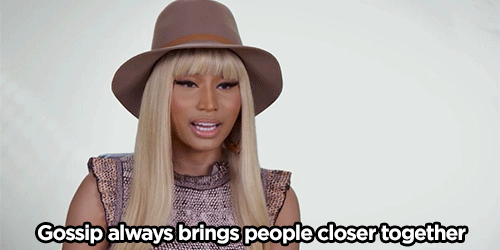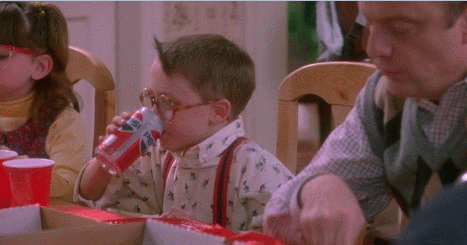17 Facts About Childbirth Throughout History
1. Pregnant women — and their midwives — used to drink beer during labor.
Budweiser / Via giphy.com
It was such a common practice that the beer had its own name: groaning beer.
2. And they were also expected to serve cake to anyone who was in the room with them as they gave birth.
Studio Ghibli / Via giphy.com
These were called groaning cakes, and in general, the women in labor were expected to cater to their guests, not to be catered to. These women were expected to make and serve these cakes — even as they were trying to push a baby out — to ease the pain of labor.
3. The word "gossip" originated with the people attending births.
VH1 / Via giphy.com
Friends of women in labor were called gossips, aka "God's sibs (siblings)." It's thought that these people sat around and chatted about others so much that the meaning of the word gossip evolved from "close to God" to "rumor or report of an intimate nature."
4. In 1951, a woman was burned at the stake for taking a pain reliever while giving birth to twins.
Paramount Pictures / Via giphy.com
Eufame Maclayne made the mistake of eating a painkilling herb while in labor. Even though she and the twins survived the birth, she was mortally punished for doing so.
5. The first pregnancy book was written by a man who had never seen nor studied childbirth.
NBC / Via giphy.com
The Rose Garden for Pregnant Women and Midwives, written by Dr. Eucharius Rösslin, was a huge hit when it came out in 1513. The only problem? Rösslin, a statistician, knew so little about pregnancy and birth that he gave outdated advice, like telling women who'd had stillborn children to remove the fetus by shoving dung, cow bile, and herbs into their vaginas. He also thought fetuses looked like adults just floating around in the womb. Still, the book was a bestseller for 200 years and was printed in five languages.
6. Before Lane Bryant invented the first line of maternity wear in the early 1900s, women wore corsets through most of their pregnancy, even though corsets were thought to crush reproductive organs and suffocate babies.
Disney / Via askfitnesscoach.com
Bryant's stretchy-waisted skirts and breezy dresses were a welcome alternative.
7. Chainsaws, the horror-movie murder weapon of choice, were invented for aid in childbirth.
Nickelodeon / Via giphy.com
The prototype for modern chainsaws was invented in the late 18th century by Scottish doctors John Aitken and James Jeffray. The hand-operated saw aided in symphysiotomy, aka cutting into and widening a woman's pelvic bone during childbirth as an alternative to a C-section. It was a risky and (obviously) painful procedure, especially before the invention of anesthesia. Luckily, symphysiotomies — and medical chainsaws in general — fell out of favor by the end of the 19th century, and chainsaws began being used to topple trees in the early 1900s.
8. In maternity wards in 17th century France, it was common for 3-5 women to share a bed during labor.
20th Century Fox / Via giphy.com
Those close quarters were not only unsanitary and likely confusing, but they were also mortifying — if a woman died during childbirth, the other women sharing a bed with her would have to wait hours for someone to take her dead body away.
9. In 1965, a patent was filed for a "birthing apparatus" which would spin pregnant women around at as much as 7G until their baby was flung out from the centrifugal force.
TV Peru / Via giphy.com
This, uh, creative childbirth aid, patented by Charlotte and George Blonsky, required a woman to be strapped onto a rotating table and spun around until the baby shot out into a cotton net. Oh, and! It was specifically designed to, among other things, concentrate "as much puke as possible in and around the mother’s face, rather than having it flung outward toward hospital staff." Somehow, it never caught on.
10. Many midwives were burned at the stake as witches.
NBC / Via giphy.com
Midwives who assisted in births that did not go well were particularly vulnerable to this because men were itching to establish their dominance in the field. Ann Hutchinson, a woman who was called a witch after a mother and baby she was helping died, later had a New York highway named after her.
11. Forceps were invented by a family who kept the design of their invention a secret for almost 200 years.
NBC / Via giphy.com
The Chamberlen family was a long line of "man midwives" who invented the very first successful pair of forceps in the 1600s. They safely delivered many babies, but refused to share their special design with other doctors. Their original pair was found in the floorboards of their old home in 1813, and soon, everyone was copying their design.
12. A book written in 1835 told women to soothe their sore post-baby ladyparts with a mixture of milk and bread, or leeches.
20th Century Fox / Via giphy.com
Birth causes "great stretching of the parts," William Edmonds Horner wrote in The Home Book of Health and Medicine. "This occasions great soreness, and uneasy feelings, which are best removed by bathing with warm milk and water. If there be much swelling, an emollient poultice of bread and milk, or linseed meal, may be applied, and frequently renewed. If there be general uneasiness, with heat and throbbing pain in the part, leeches may be necessary."
13. Queen Victoria popularized having drugs during delivery.
Cinemax / Via gfycat.com
Before the mid-1800s, it was believed that if you couldn't withstand the pain of labor, you couldn't withstand the hardships of motherhood. Either way, Queen Victoria requested to have the "blessed drug" ether while in labor in 1853, which ushered in a worldwide phenomena of getting a little ~assistance~ during childbirth.
14. An early 20th-century book once advised obstetricians to put pressure on the clitoris to help deliver a baby and ease pain.
Bravo / Via giphy.com
"During the first stages, pressure is made with the fingers on the terminal filaments of the sympathetic nerves in and around the clitoris," Louis A. Spaeth wrote in Coming Motherhoodin 1907. "The index and middle fingers are placed, one on each side of this organ, and firm, moderately hard pressure is made against the bone with the direction of the pressure upward toward the abdomen; this is done by the attending physician, the nurse, or by the woman herself. A reflex result occurs, in which contraction of the womb follows; its mouth dilates, normal propulsion pains ensue, and labor proceeds naturally, all unnecessary flying pains cease."
15. The C-section was probably NOT named after Julius Caesar.
NBC / Via giphy.com
You've probably heard that the Caesarean section surgery got its name from the famed Roman, who was supposedly the first child successfully born via that method. However, Caesar was born way before the operation was advanced enough to keep his mother alive. C-sections were more likely named after the Latin word "caesuru," which means "to cut."
16. They used to be called "C-operations," not "C-sections".
United Artists / Via giphy.com
The name was changed in the 16th century to make it sound simpler and more appealing.
17. And until the late 1800s, C-sections were only performed on women who were about to die from childbirth.
CBS / Via giphy.com
Midwives used to only do them when a woman "does not respond to penetrating odors, is ice-cold, without pulse, looks collapsed and pale as death, and if her breath leaves no traces on a mirror."


















https://www.handpowertoolslist.com/why-were-chainsaws-invented/
ReplyDelete